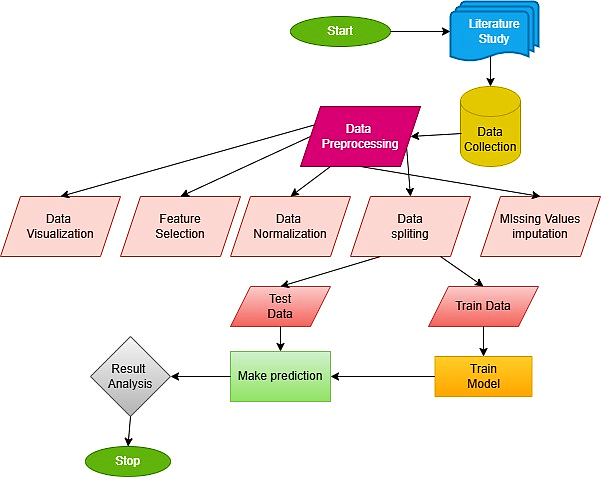An Intelligent Intrusion Detection System Using Ensemble Learning for Ultra-Dense IoT Networks
Keywords:
Intrusion, Detection, KNN, SVM, LDA, Accuracy, Confusion MatrixAbstract
Intrusion detection refers to the process of observing and analyzing network or system incidents in a perpetual manner to identify unauthorized accesses, malicious acts, or violations of the rules. It plays a pivotal role in the protection of critical information, the prevention of security breaches, and the safety, confidentiality, and availability of company assets. Strong methods to identify and stop harmful activity are required because cybersecurity threats have grown more complex due to the quick expansion of digital infrastructure. Various researchers have conducted different research studies for intrusion detection, and different methodologies, along with traditional as well as machine learning models, have been applied with various datasets for the proposed task. This research aims to address these challenges by developing an efficient and intelligent intrusion detection system using a stacking ensemble learning approach. The proposed model integrates multiple base classifiers: Decision Tree, Naïve Bayes, K-Nearest Neighbor (KNN), and Linear Discriminant Analysis (LDA) to capture diverse decision boundaries, with a Random Forest acting as the meta-classifier to aggregate and optimize final predictions. The publicly available UNSW-NB15 dataset is employed in this study for intrusion detection. Python and its libraries are used for simulation purposes. After simulation, it has been achieved that the stacked model, which combines the predictions of multiple base learners through a meta-classifier, achieved a significantly higher accuracy of 99.93%. While in comparison, LDA achieved the highest accuracy of 94.25%, followed closely by SVM at 93.05%, DT at 91.00%, NB at 90.55%, and KNC at 89.81%. This demonstrates that ensemble learning, particularly stacking, can effectively leverage the strengths of individual models to greatly enhance intrusion detection performance for complex datasets.
References
S. S. Salman Muneer, Umer Farooq, Atifa Athar, Muhammad Ahsan Raza, Taher M. Ghazal, “A Critical Review of Artificial Intelligence Based Approaches in Intrusion Detection: A Comprehensive Analysis,” J. Eng., 2024, doi: https://doi.org/10.1155/2024/3909173.
X. Wang, L. Dai, and G. Yang, “A network intrusion detection system based on deep learning in the IoT,” J. Supercomput., vol. 80, no. 16, pp. 24520–24558, Nov. 2024, doi: 10.1007/S11227-024-06345-W/METRICS.
H. L. Fanyi Zhao, “Application of Deep Learning-Based Intrusion Detection System (IDS) in Network Anomaly Traffic Detection,” Appl. Comput. Eng., vol. 86, no. 1, pp. 250–256, 2024, doi: 10.54254/2755-2721/86/20241604.
A. G. Antonio Paya, Sergio Arroni, Vicente García-Díaz, “Apollon: A robust defense system against Adversarial Machine Learning attacks in Intrusion Detection Systems,” Comput. Secur., vol. 136, p. 103546, 2024, doi: https://doi.org/10.1016/j.cose.2023.103546.
Y. Wu, B. Zou, and Y. Cao, “Current Status and Challenges and Future Trends of Deep Learning-Based Intrusion Detection Models,” J. Imaging, vol. 10, no. 10, Oct. 2024, doi: 10.3390/JIMAGING10100254,.
T. Sharath and A. Muthukumaravel, “Deep learning-powered intrusion detection systems networks using LSTM,” Adv. Intell. Networks Through Distrib. Optim., pp. 105–126, Aug. 2024, doi: 10.4018/979-8-3693-3739-4.CH006.
F. S. Rasheed Mohammad, “Enhancing Intrusion Detection Systems Using a Deep Learning and Data Augmentation Approach,” Systems, vol. 12, no. 3, p. 79, 2024, doi: https://doi.org/10.3390/systems12030079.
S. F. Halima Sadia, “Intrusion Detection System for Wireless Sensor Networks: A Machine Learning Based Approach,” IEEE Access, 2024, doi: 10.1109/ACCESS.2024.3380014.
H. J. S. Mona Esmaeili, Morteza Rahimi, Hadise Pishdast, Dorsa Farahmandazad, Matin Khajavi, “Machine Learning-Assisted Intrusion Detection for Enhancing Internet of Things Security,” arXiv:2410.01016, 2024, doi: https://doi.org/10.48550/arXiv.2410.01016.
S. Ahmadi, “Network Intrusion Detection in Cloud Environments: A Comparative Analysis of Approaches,” Int. J. Adv. Comput. Sci. Appl., vol. 15, no. 3, 2024, [Online]. Available: https://thesai.org/Publications/ViewPaper?Volume=15&Issue=3&Code=IJACSA&SerialNo=1
Q. O. Ahmed, “Machine Learning for Intrusion Detection in Cloud Environments: A Comparative Study,” J. Artif. Intell. Gen. Sci., vol. 6, no. 1, pp. 550–563, 2024, doi: 10.60087/jaigs.v6i1.287.
M. M. K. Muhammad Zawad Mahmud, Shahran Rahman Alve, Samiha Islam, “Sdn Intrusion Detection Using Machine Learning Method,” arXiv:2411.05888, 2024, doi: https://doi.org/10.48550/arXiv.2411.05888.
I. I. Khan, Y. Kanaparthi, Y. Ruchandani, and A. Rizwan, “Sustainable Security Solutions for IoT: Enhancing Intrusion Detection Using AI and Machine Learning,” 2024 3rd Int. Conf. Sustain. Mobil. Appl. Renewables Technol. SMART 2024, 2024, doi: 10.1109/SMART63170.2024.10815208.
A. Kukartsev, V., Kravtsov, K., Stefanenko, O., Podanyov, N., & Bezvorotnykh, “Using machine learning techniques to simulate network intrusion detection,” 2024 Int. Conf. Intell. Syst. Cybersecurity, 2024.
K. R. M. Muhammad Sajid, “Enhancing intrusion detection: a hybrid machine and deep learning approach,” J. Cloud Comput., vol. 13, no. 1, 2024, doi: 10.1186/s13677-024-00685-x.
S. R. Bhawana Sharma, Lokesh Sharma, Chhagan Lal, “Explainable artificial intelligence for intrusion detection in IoT networks: A deep learning based approach,” Expert Syst. Appl., vol. 238, p. 121751, 2024, doi: https://doi.org/10.1016/j.eswa.2023.121751.
F. S. Ashraf, W., Ahanger, A. S., & Masoodi, “Enhancing Intrusion Detection using Supervised Machine Learning Algorithms,” 2024 11th Int. Conf. Comput. Sustain. Glob. Dev., 2024.
H. Nandanwar and R. Katarya, “Deep learning enabled intrusion detection system for Industrial IOT environment,” Expert Syst. Appl., vol. 249, p. 123808, 2024, doi: https://doi.org/10.1016/j.eswa.2024.123808.
F. Hussain, S. A. Hassan, R. Hussain, and E. Hossain, “Machine Learning for Resource Management in Cellular and IoT Networks: Potentials, Current Solutions, and Open Challenges,” IEEE Commun. Surv. Tutorials, vol. 22, no. 2, pp. 1251–1275, Apr. 2020, doi: 10.1109/COMST.2020.2964534.
F. Hussain, R. Hussain, S. A. Hassan, and E. Hossain, “Machine Learning in IoT Security: Current Solutions and Future Challenges,” IEEE Commun. Surv. Tutorials, vol. 22, no. 3, pp. 1686–1721, Jul. 2020, doi: 10.1109/COMST.2020.2986444.
Y. X. Junxiong Chai, “Secure multi-channel information encryption based on integrated optical device,” Expert Syst. Appl., vol. 249, 2024, doi: https://doi.org/10.1016/j.eswa.2024.123837.
M. Mynuddin et al., “Automatic Network Intrusion Detection System Using Machine learning and Deep learning,” IEEE Int. Conf. Artif. Intell. Mechatronics Syst. , Feb. 2024, doi: 10.36227/TECHRXIV.170792293.35058961/V1.
F. F. Nahida Islam, “Towards Machine Learning Based Intrusion Detection in IoT Networks,” Comput. Mater. Contin., vol. 69, no. 2, pp. 1801–1821, 2021, doi: 10.32604/cmc.2021.018466.
S. A. Abdulazeez Khlaif, “Intrusion Detection System Based on Machine Learning Algorithms:( SVM and Genetic Algorithm),” Babylonian J. Mach. Learn., 2024, [Online]. Available: https://mesopotamian.press/journals/index.php/BJML/article/view/256
E. A. Muhammad Muntazir Khan, Muhammad Zubair Rehman, Abdullah Khan, “Anomaly detection in network traffic with ELSC learning algorithm,” Electron. Lett., vol. 16, no. 14, 2024, doi: https://doi.org/10.1049/ell2.13235.
M. I. & M. A. Yousef Alhwaiti, Muntazir Khan, Muhammad Asim, Muhammad Hameed Siddiqi, “Leveraging YOLO deep learning models to enhance plant disease identification,” Sci. Rep., vol. 15, p. 7969, 2025, doi: https://doi.org/10.1038/s41598-025-92143-0.
S. A. Lashari, M. M. Khan, A. Khan, S. Salahuddin, and M. N. Ata, “Comparative Evaluation of Machine Learning Models for Mobile Phone Price Prediction: Assessing Accuracy, Robustness, and Generalization Performance,” J. Informatics Web Eng., vol. 3, no. 3, pp. 147–163, Oct. 2024, doi: 10.33093/JIWE.2024.3.3.9.
M. Imran, J. Usman, M. Khan, and A. Khan, “A Hybrid Deep Learning VGG-16 Based SVM Model for Vehicle Type Classification,” J. Informatics Web Eng., vol. 4, no. 1, pp. 152–167, Feb. 2025, doi: 10.33093/JIWE.2025.4.1.12.
M. B. M. S. Asfandyar Khan, Abdullah Khan, Muhammad Muntazir Khan, Kamran Farid, Muhammad Mansoor Alam, “Cardiovascular and Diabetes Diseases Classification Using Ensemble Stacking Classifiers with SVM as a Meta Classifier,” Diagnostics, vol. 12, no. 11, p. 2595, 2022, doi: https://doi.org/10.3390/diagnostics12112595.
M. I. Muhammad Muntazir Khan, “Network Traffic Classification in SDN Networks Using PCA Integrated Boosting Algorithms,” Int. J. Innov. Sci. Technol., vol. 7, no. 2, pp. 856–870, 2025, [Online]. Available: https://www.researchgate.net/publication/393148501_Network_Traffic_Classification_in_SDN_Networks_Using_PCA_Integrated_Boosting_Algorithms

Downloads
Published
How to Cite
Issue
Section
License
Copyright (c) 2025 50sea

This work is licensed under a Creative Commons Attribution 4.0 International License.




















